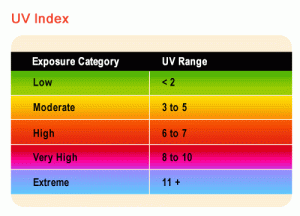 The ultraviolet index, or UV index, is an international standard measurement of the strength of the sunburn-producing ultraviolet (UV) radiation at a particular place and time.
The ultraviolet index, or UV index, is an international standard measurement of the strength of the sunburn-producing ultraviolet (UV) radiation at a particular place and time.
The UV index is an open-ended linear scale, directly proportional to the intensity of UV radiation that causes human skin to sunburn.
Using the Fitzpatrick scale, a light-skinned individual would experience sunburn in about 30 minutes at UV index 6, without sunscreen.
That same individual would experience sunburn in only 15 minutes if the UV index was at 12.
The UV index is to helps people to protect themselves from UV radiation.
UV has health benefits in moderation but in excess causes sunburn, skin aging, DNA damage, skin cancer, immunosuppression, and eye damage, such as cataracts.
It is recommended that people protect themselves if they spend substantial time outdoors when the UV index is 3 or higher.
The UV index uses a linear scale.
Each increase in value corresponds to a constant decrease in time to sunburn.
Higher values represent a greater risk of sunburn due to UV exposure.
An index of 0 corresponds to zero UV radiation, the case at night.
An index of 10 corresponded roughly to midday summer sunlight with a clear sky when the UV index was originally designed.
Summertime index values in the tens are common for tropical latitudes, mountainous altitudes, areas with ice/water reflectivity and areas with above-average ozone layer depletion.
The sun’s highest point in the day, called solar noon, is halfway between sunrise and sunset, and typically occurs between 11:30 and 12:30, or between 12:30 and 13:30 in areas where daylight saving time is being observed.
The effects of sun-earth distance, solar zenith angle, total ozone amount, tropospheric aerosol optical depth, elevation, snow/ice reflectivity and cloud transmission influence the amount of UV radiation at the surface are accounted for in the index.
The UV index is linear and increase at a constant rate.
Sunburn’s effects, as measured by the UV index, is the product of the sunlight radiation intensity and the erythemal action spectrum, or, skin sensitivity across the range of UV wavelengths.
The UV index is a number related to the intensity of sunburn-producing UV radiation at a given point on the Earth’s surface.
The UV of greatest concern occupies a spectrum of wavelengths from 295 to 325 nm, and shorter wavelengths have already been absorbed a great deal when they arrive at the earth’s surface.
Skin damage from sunburn is related to wavelength, the shorter wavelengths being much more damaging.
People with darker skin (Fitzpatrick scale: Type IV+) are more likely to withstand greater sun exposure, while extra precautions are needed for children, seniors, particularly fair-skinned adults, and those who have greater sun sensitivity for medical reasons or from UV exposure in previous days.
UV index: Risk of harm from unprotected sun exposure, for the average adult
Recommended protection
0 – 2 Green Low A UV index reading of 0 to 2 means low danger from the Sun’s UV rays for the average person.
Bright surfaces, sand, water, and snow,will increase UV exposure.
3 – 5 Yellow- Moderate- a UV index reading of 3 to 5 means moderate risk of harm from unprotected sun exposure.
Bright surfaces, such as sand, water, and snow, will increase UV exposure.
A UV index reading of 6 to 7 means high risk of harm from unprotected sun exposure, and protection against skin and eye damage is needed, reduce time in the sun between 10 a.m. and 4 p.m., seek shade and wear sun-protective clothing, a wide-brimmed hat, and UV-blocking sunglasses, apply broad spectrum SPF 15+ sunscreen every 1.5 hours, even on cloudy days, and after swimming or sweating.
Bright surfaces, such as sand, water, and snow, will increase UV exposure.
A UV index reading of 8 to 10 means very high risk of harm from unprotected sun exposure.
A UV index reading of 11 or more means extreme risk of harm from unprotected sun exposure.
